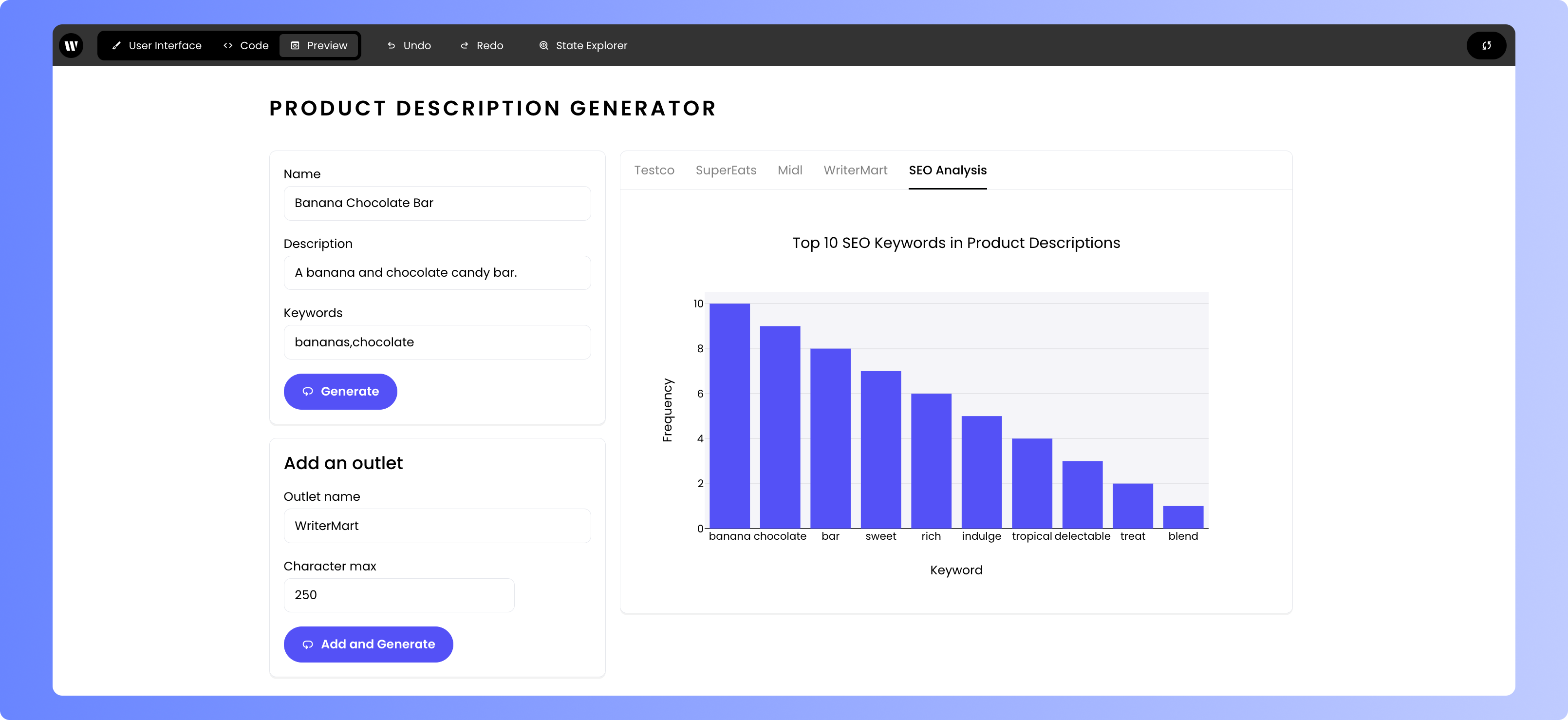
Setting up your project
Creating a Writer app and getting your API key
From the Home screen, click on Build an app.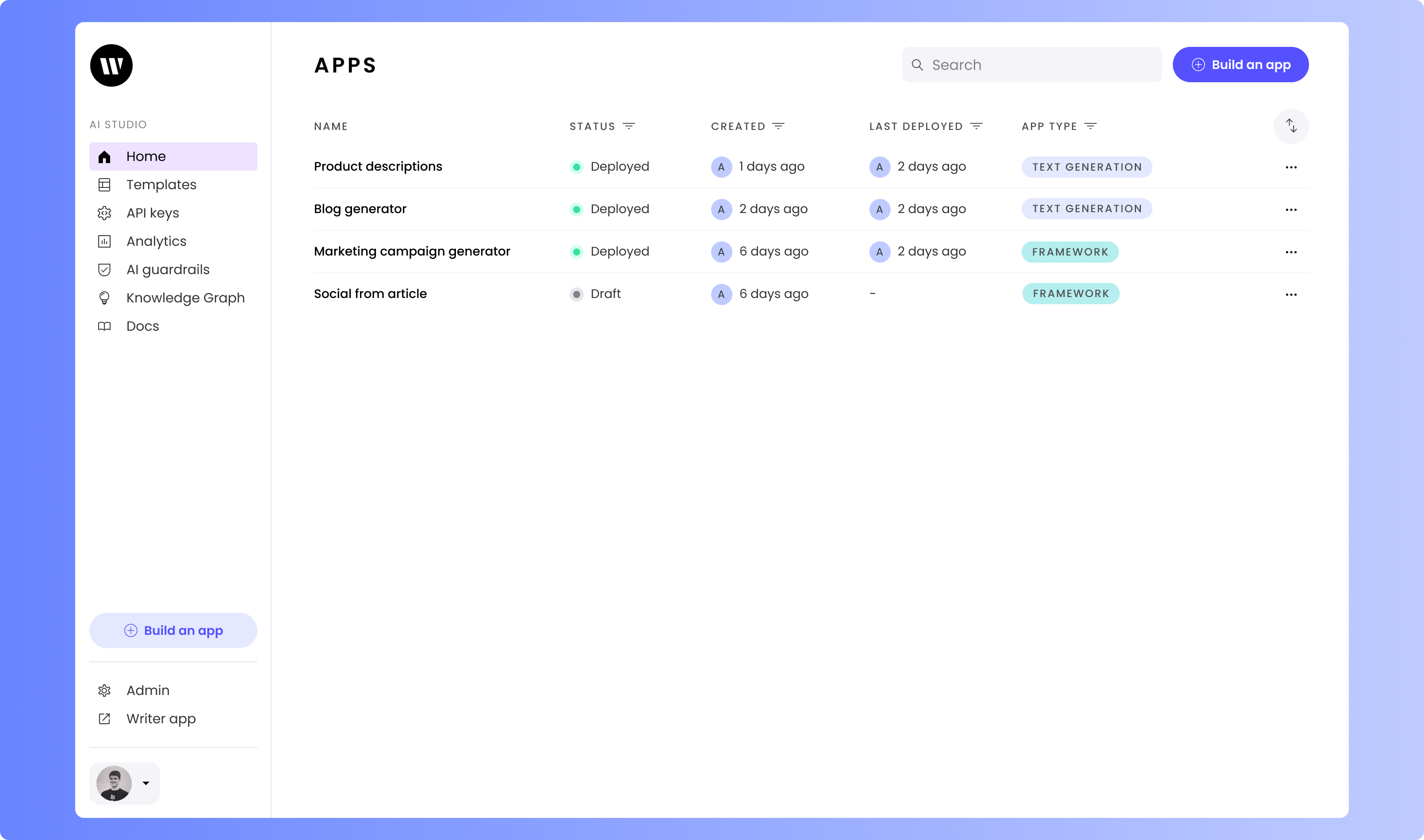
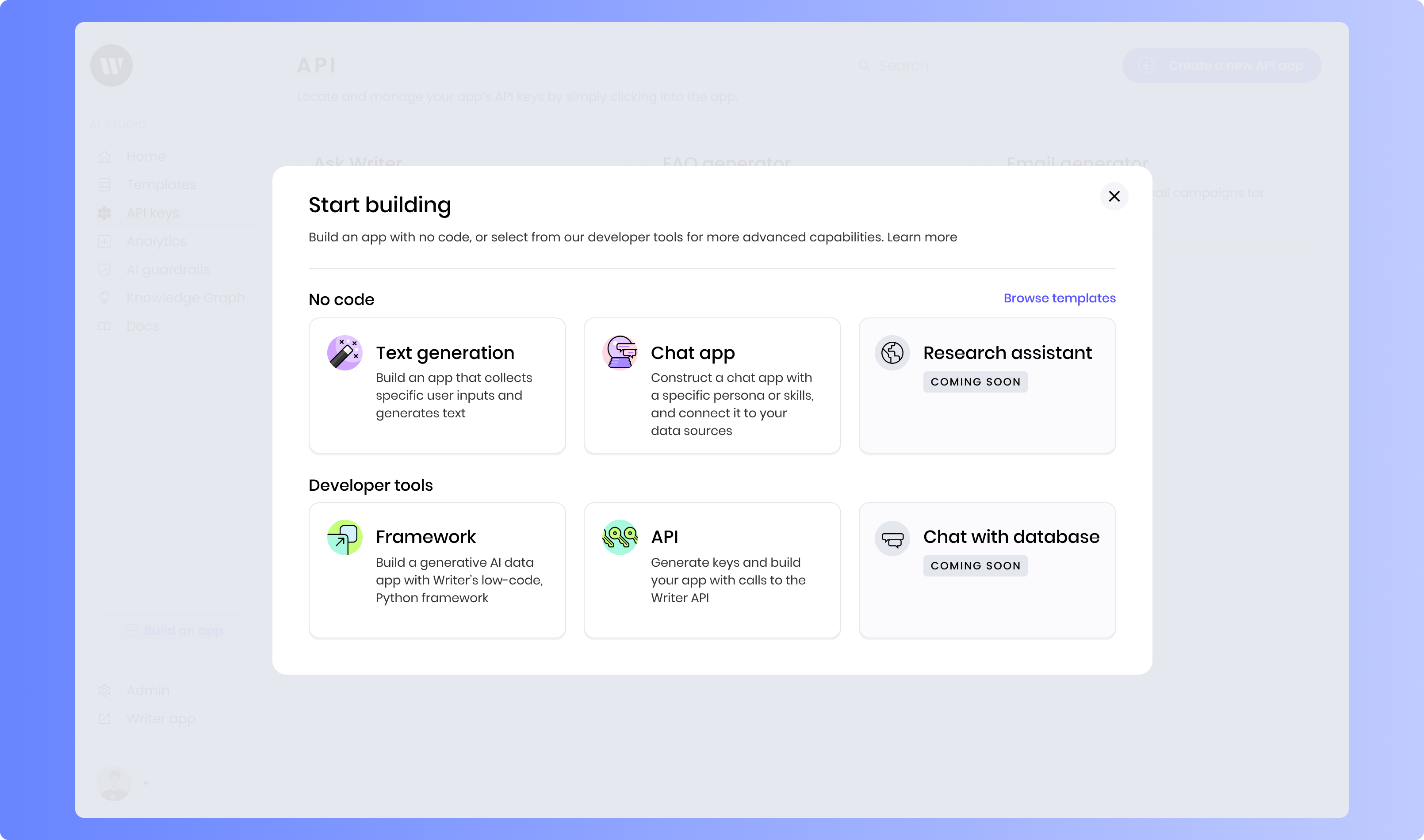
Creating the application
Next, open your terminal and navigate to the directory where you want to create your application directory.1
Set the API key environment variable
To pass your API key to the Writer Framework, you’ll need to set an environment variable called
WRITER_API_KEY. Here’s how you can set this variable in your terminal session:2
Create the application
Run the following command to create your application. Replace This command sets up a new project called
product-description-app with your desired project name and pdg-tutorial with the template you wish to use:product-description-app in the specified directory using a template designed for this tutorial.3
Edit your project
To edit your project, run the below commands. This will bring up the console, where Framework-wide messages and errors will appear, including logs from the API. By default, the Writer Framework Builder is accessible at
localhost:4005. If that port is in use, you can specify a different port. Open this address in your browser to view your default application setup.Introduction to the application setup
When you first start up the application, you’re going to see two main layout items provided by the template:- A Header component with the name of the application
- A Column container that’ll house most of the UI of the app
Code overview
Looking at the code inmain.py, you’ll see that the template already imported the Writer Framework, the AI module, and the product description prompts that you’ll use throughout this tutorial.
prompts.py. You are welcome to open this project in the IDE of your choice and modify the prompts however you wish. However, you don’t need to make any changes to this file to follow this tutorial.
You’ll also see the state initialization:
Implementing the Product description generator
Your first goal is to generate product descriptions for the various food outlets, with each outlet appearing as a tab to the right of the form.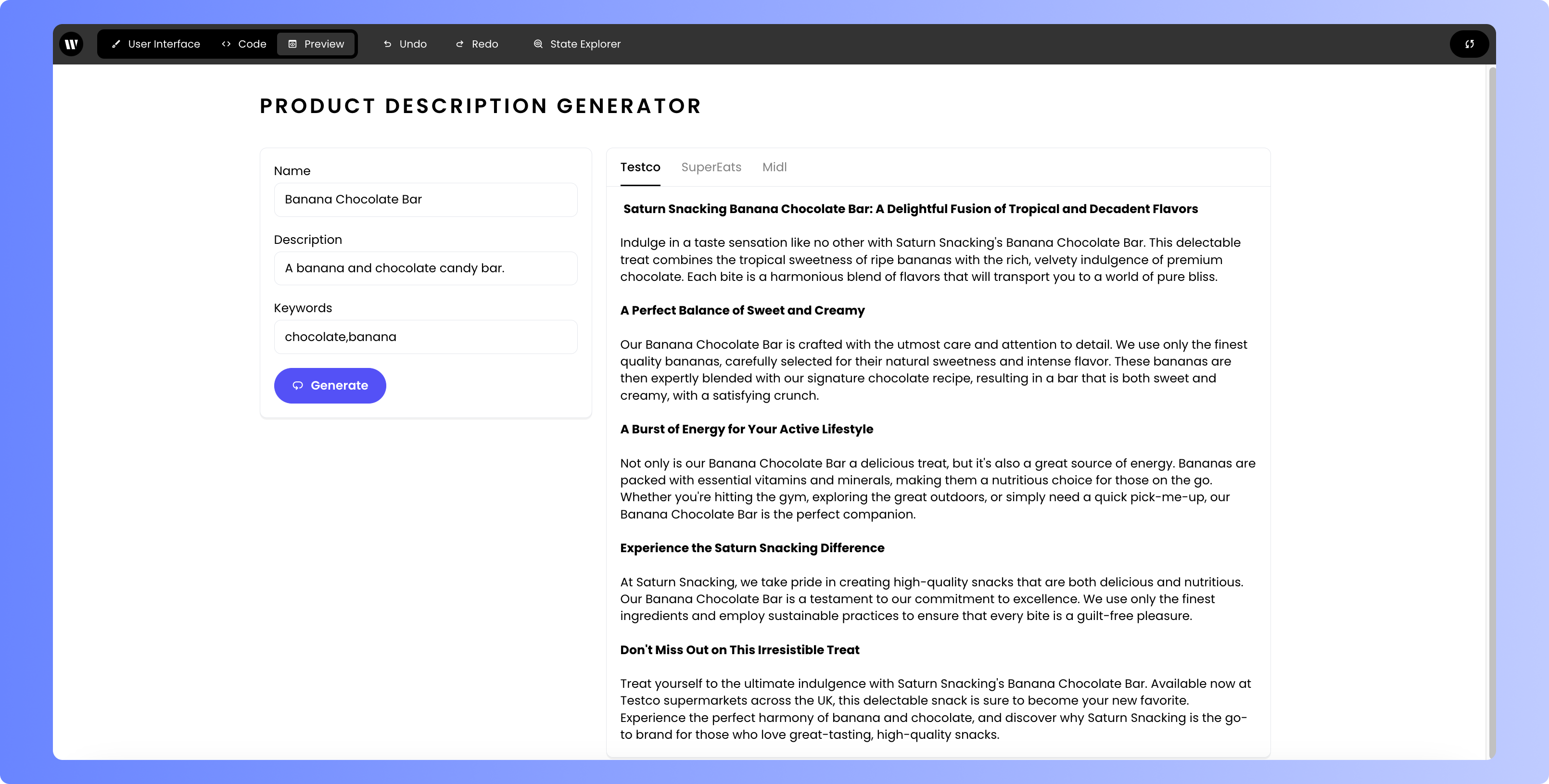
Setting up the code
First, integrate new functionality into your code for generating product descriptions.1
Add a private helper method
Paste the following method on line 5 after all of the imports to create a helper function for generating product descriptions:This function,
_generate_product_description, accepts a base prompt and the product information from a form on the page. The underscore at the beginning of its name indicates that it’s a private method not exposed to the UI.2
Initialize additional state elements
Update the This setup includes a variable
wf.init_state() to include a product_description dictionary with visibility control and outlets for descriptions:visible to control whether product description tabs are shown or hidden, and an empty dictionary outlets for storing descriptions.3
Add a button click handler
Paste the following method beneath This handler will loop through each imported base prompt, format it with the form information, and pass it to the helper method. The handler also manages UI interactions, such as displaying and hiding product descriptions and managing loading messages.
_generate_product_description to handle button clicks and generate descriptions:Setting up the user interface
You can now set up the UI to iterate over the product descriptions dictionary and create tabs. Begin by opening the User Interface.1
Add and configure the Repeater component
In the toolkit, drag a Repeater component from the Other section into the empty Tab Container. Click on the Repeater component to open its component settings. Under Properties, add 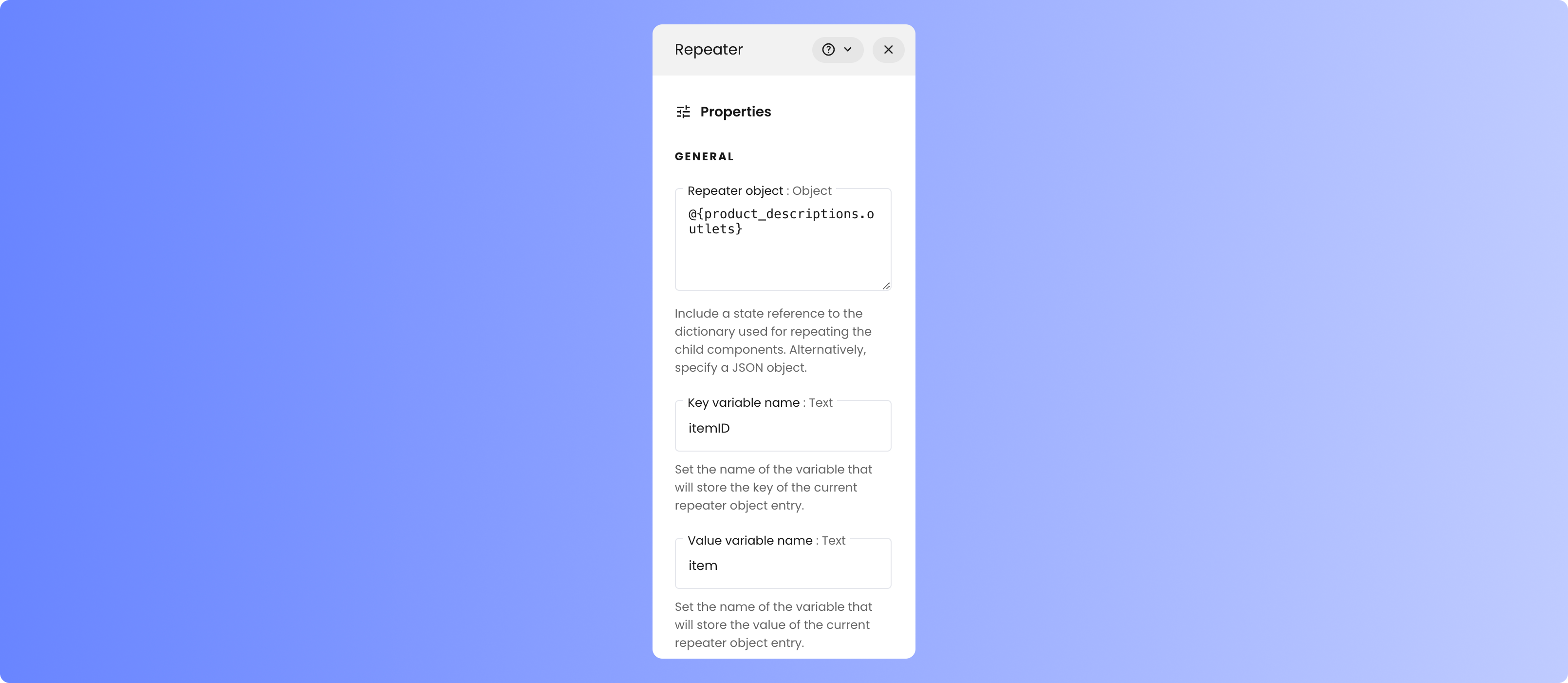
@{product_descriptions.outlets} as the Repeater object to be used for repeating the child components. Replace the default “Key variable name” with itemId. You can leave “Value variable name” as item.
2
Add and configure the Tab component
From the Layout section of the toolkit, drag a Tab component into the Repeater. Click on the Tab to bring up the component settings and add 
@{itemId} to the Name property to display the outlet name on the tab.
3
Add and configure the Text component
Drag a Text component from the Content section of the Toolkit into the Tab. Click on the Text component to open the Component settings and set the Text property to 
@{item}. You may also choose to set “Use Markdown” to “yes.”
4
Control the visibility of the Tab container
Click on the Tab container to bring up its Component settings. Scroll to the bottom and, under Visibility, click “Custom” and add 
product_descriptions.visible to the Visibility value input.
5
Wire up the form with the Generate button
Click on the Generate button inside the form to bring up its Component settings. In the Events section, select 
handle_click for the wf-click event.
6
Preview and test the application
Click Preview in the top toolbar, enter some test data, and click the Generate button. You should see a loading message, as well as three example food outlets displayed in the tabs. The loading message should disappear when everything is loaded, and the tab should remain visible once the data has loaded.Great work!
Expanding the application: SEO keyword analysis
You can expand on this application by adding a chart that displays the top ten SEO keywords present in the product descriptions.Updating the code
To do this, back in the code, first add the following helper function underneath your _generate_product_description helper method:
prompts.py. It then sends the formatted prompt to the Palmyra LLM using the complete method. The prompt not only analyzes the descriptions for SEO keywords, but also outputs a Plotly.js schema object that you can use directly with a Plotly graph component.
With the helper method in place, you can now update the click handler for the button. On line 27, add the following code before the product description visibility is set:
Adding SEO analysis to the UI
To update the UI to display this chart, first drag a new tab from the Layout section of the toolkit into the Tab container. This tab should not be inside of the Repeater, but can be either before or after it. Click on the tab to open the component settings, and change the name to “SEO Analysis.” If you’d like, you can also set the Visibility to “Custom” and setseo_analysis as the visibility value.

@{seo_analysis} to pass the LLM-generated graph specification to the component.
Click preview, add some data to the form, and click generate. You should see a new SEO analysis tab appear with a nicely formatted and labeled chart.
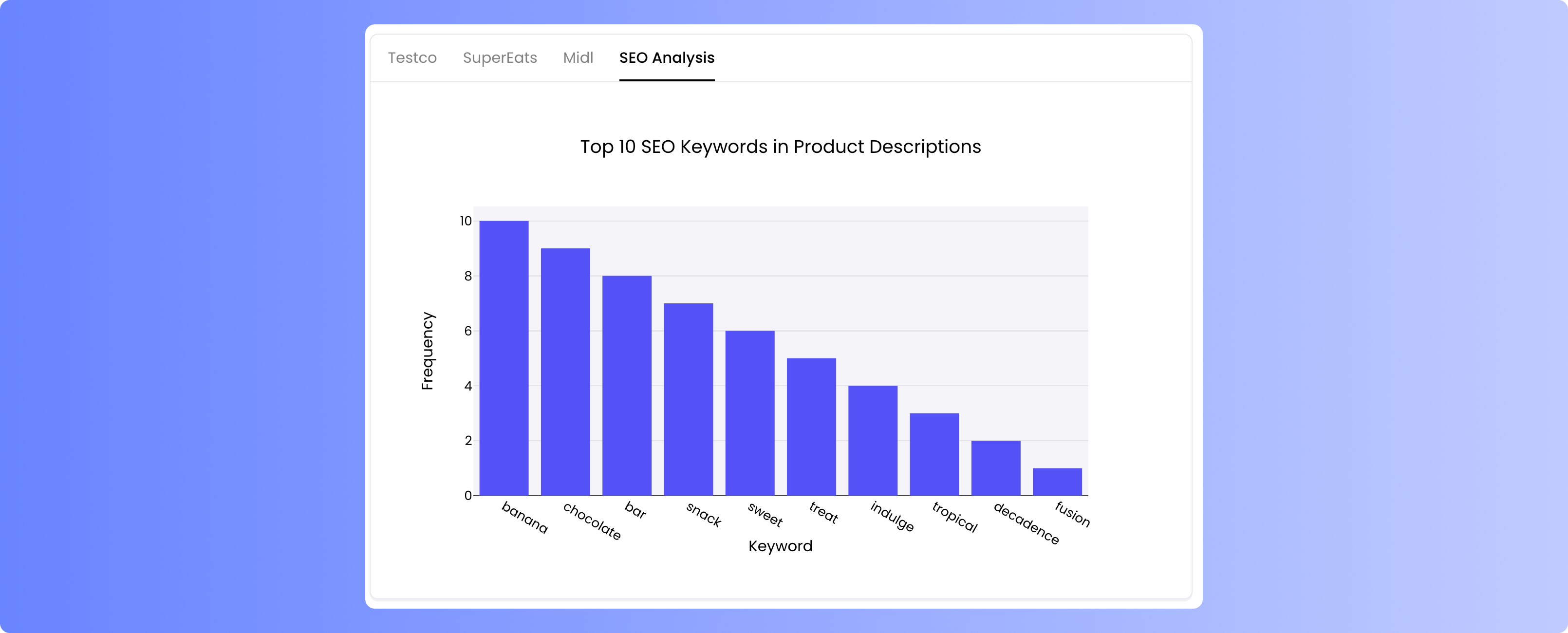
Extending the application: user-added outlet
Finally, you can extend this application even further by allowing users to add their own custom food outlet and derive a new description from a custom prompt.Adding the new form
Start by building the UI for this new form. From the Layout section of the Toolkit, drag a new Section component into the column where the current form is and drop it above or below it. Click on the Section and change the Name to “Add an outlet.” To create the inputs for the form, drag a Text Input and a Number Input from the Input section of the Toolkit into the newly created section. Click on the Text Input component to change the Label to “Outlet name.” Click on the Number Input and change the label to “Character max.” Finally, add a Button from the Other section of the toolkit to the bottom of the new section. Click on the button and change the text to “Add and Generate.” You can also addlaps or another Material Symbols ID to the Icon input if you wish.

Updating the code
In the code, you next need to add corresponding state elements for the new form components towf.init_state(). Add the following to the state dictionary:
outlet_form state elements will bind to the form elements.
Next, add the click handler for the new button. Copy and paste this handle_add_outlet method into the code under the handle_click method:
user_prompt and adds the formatted prompt to the base_prompts dictionary. It then generates the product description for the new food outlet, updates the SEO analysis, and clears the status message.
Binding the elements and handler to the UI
Finalize your setup by binding the state elements and configuring the click handler to the UI components.1
Bind text inputs to state elements
- Outlet Name: Click on the “Outlet name” Text Input component. In the Binding section of the component settings, set the state element to
outlet_form.name. - Character Max: Move to the “Character max” Text Input. Update its state element binding to
outlet_form.character_max.
2
Assign click handler to button
Click on the Add and Generate Button. In the Events section of the component settings, select
handle_add_outlet for the wf-click event.3
Configure form visibility
To conditionally display the form based on whether descriptions have been generated, click on the Section containing the form. In the Visibility section, choose “Custom” and set
product_descriptions.visible as the “Visibility value.”Testing the finished product
To see the result of your hard work, click Preview in the top toolbar, enter some information into the original product description form, and click Generate. The “Add an outlet” form should appear once the product descriptions have been generated. Add a new example outlet name and a character max and click “Add and Generate.” You should see a new tab appear with your new outlet, as well as an updated SEO analysis chart.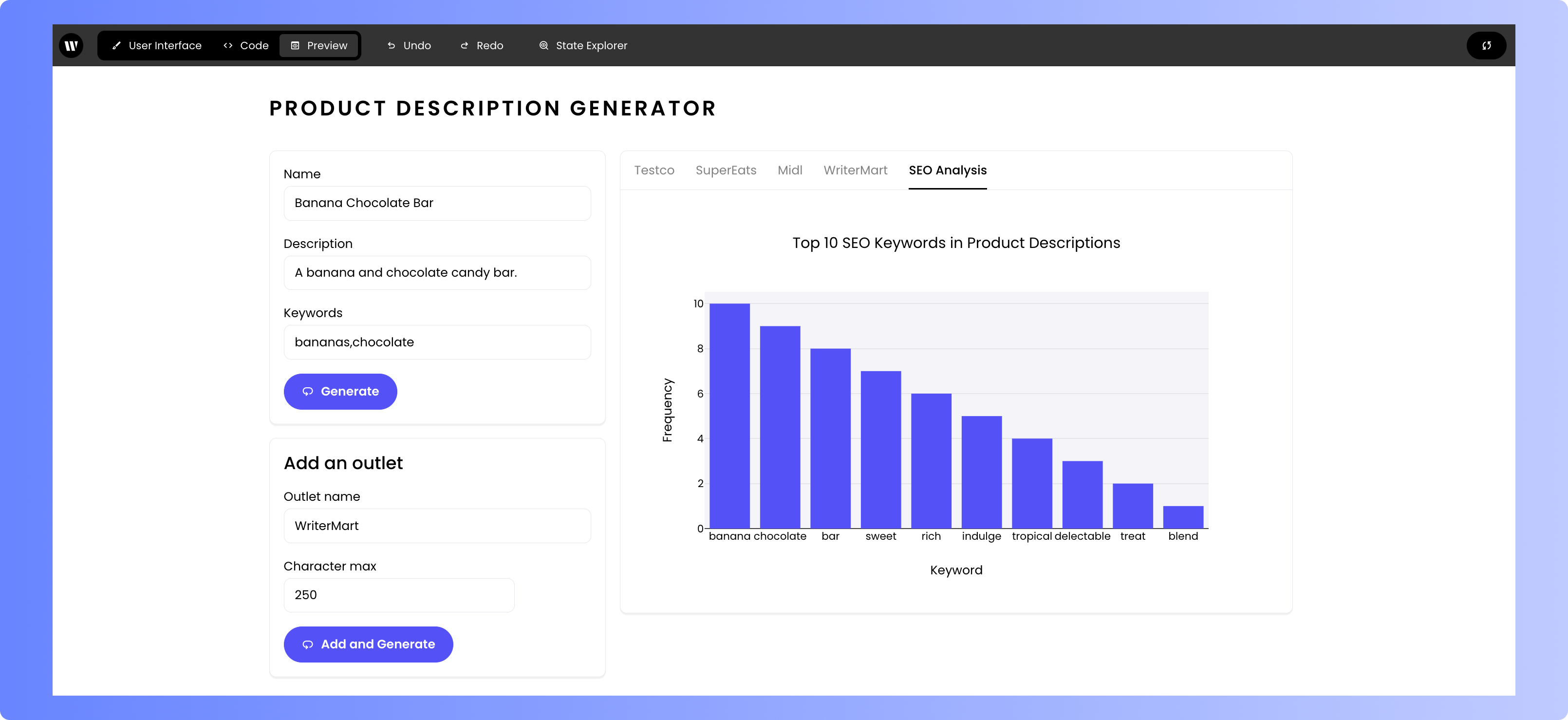
user_prompt in the prompts.py file using your favorite editor.